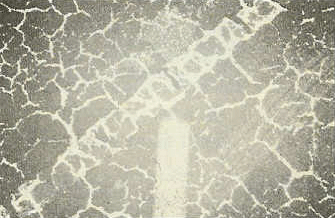Did you realize that in attempting to maintain your asphalt pavements by placing water-based sealcoats on them, you could be losing one-third to one-half of the pavements useful service life? An asphalt pavement placed today should typically yield 15 to 20 years of practical service life if nothing is done in terms of maintaining it.
To keep the rich black appearance of the new asphalt surface and extend the life of this investment, many associations adopt a maintenance program centered around sealcoating. If you decide to implement such a program, you can expect the following course of events.
Two years after the pavement is laid, a coal-tar emulsion of water-based sealcoat is put in place on the pavement. Soon after the coating goes down, it appears to wear off in driving lanes. As the selacoated pavement ages, small hairline cracks begin to appear on the surface, causing concern. Your budget, however, calls for sealcoating every three years, so when the pavement is five years old, you place a second sealcoat on it. With time, this coating also wears and what were hairline cracks become larger, as do your concerns.
In keeping with your budget, the next sealcoat is applied when the pavement is eight years old. As you wait and watch, the same degeneration of the sealcoat takes place.
 When putting together your
maintenance budgets, you examine your asphalt pavement areas. That pavement,
which is now ten years old, has been maintained with three sealcoats, applied
three years apart. So now, at year ten of the pavements life, the surface is so
badly cracked in the areas where the coating has not worn off that you feel your
only solution to the unsightly, cracked appearance is to overlay the pavement
with a new layer of asphalt.
When putting together your
maintenance budgets, you examine your asphalt pavement areas. That pavement,
which is now ten years old, has been maintained with three sealcoats, applied
three years apart. So now, at year ten of the pavements life, the surface is so
badly cracked in the areas where the coating has not worn off that you feel your
only solution to the unsightly, cracked appearance is to overlay the pavement
with a new layer of asphalt.
Look what you have done. You have spent good money over a 10-year period to maintain your investment, only to have your maintenance practice force you to overlay your pavement five to 10 years earlier than you would have to if you done nothing at all.
With this scenario in mind, consider this question: Are sealcoats all theyre cracked up to be?
I am not recommending that you forego maintenance; that would be impractical. What I do recommend is to incorporate into your pavement maintenance program a treatment that has been proven to extend the life of your asphalt pavements. This will allow you to postpone the need for costly overlays or reconstruction.
The Florida Department of Transportation has developed a specification that outlines the application of a material that is comprised of coal-tar oils and coal-tar distillates, combined with a maltenous-type rejuvenator. This material is named Pavement Dressing Conditioner (PDC) rejuvenator/sealer. When applied to an asphalt pavement, PDC will seal and protect the pavement from the deterioration that results from fuel spills and water damage and oxidation, as well as restore flexibility and durability while revitalizing the asphalts oils. The process is called rejuvenation, and its been proven to work. Application of PDC rejuvenator/sealer every three to five years will suspend the aging process of asphalt. When applied to older pavement, this treatment will actually reverse aging.
The reason water-based or emulsion sealcoats fail has to do with their composition. Because they are formulated with varying water content and coal-tar solids, they form a rigid laminate or veneer on the pavement surface. These coatings cannot expand and contract through daily thermal cycling at the same rate as the coated pavement. The rigid coating is unable to cycle with the pavement as the pavement heats up and expands during the day, and cools down and shrinks at night. For this reason, hairline cracks form in the seal.
Reapplying sealcoats to eliminate cracking is futile. The cracks will only reappear and typically get larger. Subsequent re-cracking will actually migrate into and damage the pavement itself.
PDC contains no water, thereby allowing the rejuvenator/sealer to penetrate into and become an integral part of the pavement. By being in the pavement and not just on it, the treatment expands and contracts with the pavement through thermal cycles. The result: no unsightly coating cracks.
PDC gives true meaning to the word maintenance. The PDC treatment protects the pavement with tough fuel and water-resistant ingredients. And the rejuvenator portion soaks into the aging pavement to restore suppleness and extend pavement life.
Pavement Dressing Conditioner (PDC) asphalt rejuvenator/sealer has been applied throughout the state of Florida to pavements as varied as airport runways, commercial shopping centers, apartments and numerous community association roads and parking areas.
